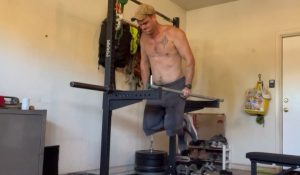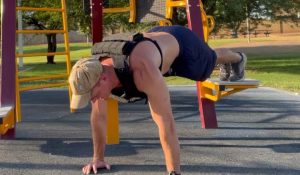Whether you’re a serious gym goer or a devotee of weighted calisthenics and weight vest training, I believe it’s a mistake to skip weighted push-ups. Weighted push-ups should be a staple upper-body exercise. Why? They’re simple, and they work.
Weighted push-ups are an excellent mass and strength builder for the upper body. Done properly, for 10-20 sets per week within 1-3 repetitions of muscular failure, weighted push-ups can add slabs of muscle to your upper body. It’s easy to bias this exercise for the upper chest, and it also fits neatly into calisthenic circuit training for maximum time savings.
If we’re following these best practices for resistance training, then all we’re doing by switching to weighted pushups is using the amount of weight that allows us to reach failure between 6-30 repetitions per set, which shouldn’t be too complicated to figure out.
But first:
Aren’t weighted push-ups for sissies?
There exists a notion in the lifting world that push-ups are a beginner’s exercise. While it’s true that basic bodyweight exercises like push-ups and squats are a great place to start our fitness journey, folks tend to become very efficient on these exercises once they become just a little bit stronger than they started.
You’ll find lifters who are capable of cranking out dozens and dozens of reps, effectively turning push-ups into a poor substitute for a conditioning exercise (you may even be one of these people).
These lifters are usually slashing the range of motion by using a wide grip and not locking out their reps at the top. They are also generally aiming for rep goals – thereby missing the point of the exercise.
I would submit to those people that they likely haven’t ever taken weighted push-ups seriously.
Rather than switching to glorified “party trick” exercises, I recommend simply making push-ups harder by adding weight.
Benefits of weighted push-ups
Greater range of motion than the bench press
Many folks I speak with on this issue haven’t thought this through: weighted push-ups (and push-ups in general) have a greater range of motion than the bench press. This is for two reasons:
- The bottom is lower: In the bench press, you’re arching your back to get tight, thus limiting the depth that the bar can travel. The bar stops at the height of the lower sternum / upper stomach area. In push-ups, we’re using a flat back, allowing us to bring the hands all the way down the level of the chest.
- The top is higher: In the bench press, we’re stopping the range of motion as soon as the elbows are straightened, but keeping the scapula pinched together in order to stay tight for the next rep. In the push-up, we’re allowing the scapula to rotate forward in order to get a good “squeeze” at the top of the rep.
Both of these differences allow for an extra couple of inches at the bottom and top of the rep, respectively, leading to a significantly greater range of motion. We can further extend the range of motion in the push-up in simple ways: by using push-up handles or weight plates to elevate the hands.
On a bench press, we’d need to switch to an expensive specialty bar (camber bar or buffalo bar) in order to achieve this effect. This is an okay solution, but certainly not a cost-effective one!
Hit the upper chest with ease
The push-up is extremely simple to modify to bias the stress toward the upper chest. All we need to do is:
- Narrow the grip to create the desired angle between the humerus and torso.
- Elevate the butt slightly in order to create a “decline” angle between the torso and the ground.
- Imagine pressing upward and inward in a triangular motion, squeezing at the top of the rep.
That’s it. If you’ve never “felt” your upper chest on a push-up, it will shock you how these simple modifications will bias the stress toward the upper chest. Combine these cues with elevated feet in order to modulate the stress according to your goals and strength level.
Utilizing these cues in combination with a weighted push-up of some sort will cause you to rethink the need for fancy upper chest exercises!
More joint-friendly than dips, on average
Of course, the other obvious compound exercise to substitute for push-ups would be dips. In fact, folks looking specifically to build strength from weighted calisthenics often ask me which is better: push-ups or dips.
While there’s some nuance to the answer, one big factor to consider is that push-ups, whether weighted or unweighted, tend to be more joint-friendly on average.
I say “on average” because I acknowledge that everyone is different. Please don’t read this section and hear “dips are dangerous.” They aren’t. Dips have many benefits, and they are awesome. BUT …
Some folks’ sternums or shoulders don’t tolerate dips very well. I am one of those people – if I start using weighted dips more frequently than once per week, I start to develop nagging pains. What’s the solution? Spend the rest of the week doing weighted push-ups!
If you fall into that category, then weighted push-ups are likely going to give you a similar effect with far less trouble modulating your stimulus-to-fatigue ratio.
Benefits of weighted vest push-ups
If you haven’t been keeping track, I think the weighted vest is likely the most underrated tool for weighted calisthenics. For that reason, I believe that the benefits of push-ups with a weighted vest are even more numerous, some of which are unique from traditional weighted push-ups with a weight plate or dip belt around the torso. The reasons are simple:
Ultimate portability and simplicity
Perhaps the most obvious benefit of the weighted push-up is that it’s portable, if we’re using a weighted vest. If you’re using a weighted vest, instead of a weight belt or weight plate, the vest can literally go with you anywhere.
I’ve made no secret that I’m a massive fan of running in a weighted vest and then utilizing weighted calisthenics at the various locations I run to. I believe it’s likely the most underrated way to combine cardiovascular exercise with strength training.
Of course, you could achieve a similar benefit by using resistance bands, but then we’re making a tradeoff where the exercise itself becomes easier towards the most hypertrophic portion of the rep.
Fantastic for calisthenic circuit training
If you’ve ever tried to do calisthenic circuit training with weight vest squats and pull-ups, you’ve likely run into a couple of two limitations:
- Weighting and unweighting each exercise becomes so cumbersome that you eventually just give up
- Doing the exercises unweighted becomes a glorified cardio session
This is where the weight vest shines – it’s literally an article of clothing. Do you push-ups, then move directly into your rows, pull-ups, walking lunges, or whatever’s next. You can even combine it with running if you so desire.
Avoid the party tricks, keep it simple
If you’re capable of cranking out dozens of push-ups in one go, it’s tempting to start working on what I often call “party trick” push-up variations. Do yourself a favor and simply add some weight to your push-ups. You’ll be glad you did!





















